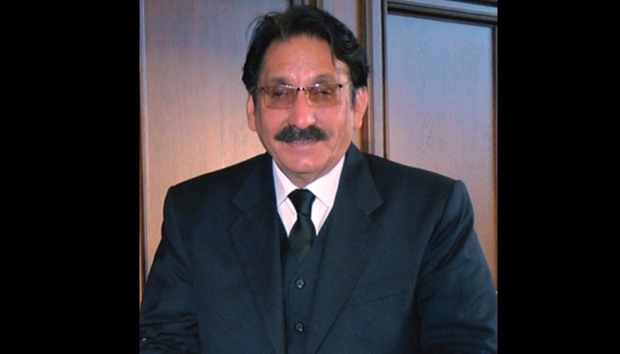The Lawyers’ Movement aimed at the restorations of an errantly sacked chief justice, not for a chief justice who became errant after restoration
This month marks a full decade since one of most momentous chapters were written in Pakistan’s judicial history. It was a bright spring morning in the federal capital Islamabad; March 13, 2007, to be precise. The stage was a commotion on a road in the famous Red Zone involving blue-uniformed, metal-grey painted helmet-wearing posse of policemen surrounding someone nearly invisible to watchers.
An accidentally well-placed photojournalist managed to, in the split-second available to him, capture an image that changed the course of contemporary Pakistani history. It showed a black suited moustachioed captive being rudely shoved into a car, a police officer contemptuously clutching his short-cropped hair in disdain.
The captive was the-then Chief Justice Iftikhar Chaudhry, who had refused to accept his sacking the previous day by the military dictator in power. When intercepted, he was on his way to the Supreme Court on foot as his car was taken away to prevent him from attending office.
This was the photo that launched a thousand news reports on the hundreds of protests by the lawyers’ community across Pakistan over the next several months that snowballed first into a movement and then into a political resistance that eventually resulted in the chief justice being reinstated, re-sacked and re-reinstated and the general finally vacating his labyrinth.
The photo captured in breathtaking simplicity the eternal quarrel of truth with power – particularly in Pakistan’s context where the stakes are always high.
While this photo is considered one of the prime triggers of the Lawyers’ Movement, looking back closely a decade later provides a more nuanced picture of the sentiment of the campaign and its parental spontaneity. And also how widespread it was and what its objectives were even if they were, strictly speaking, not carved out before the Movement began but began crystallising only when it became clear that neither the general nor the judge would budge.
It was only a matter of ‘when’ the Lawyers’ Movement would be birthed, rather than ‘if’, after a bench headed by the chief justice halted the-then President General Pervez Musharraf’s advanced plans to privatise the Pakistan Steel Mills.
Stung by this, Musharraf sent a reference to the Supreme Judicial Council (SJC) against Chaudhry and attempted a forced resignation from the latter by intimidating him through a show of uniformed force at the President House. When he refused, Musharraf sacked Chaudhry and put him in detention. The picture-worth-a-thousand-words triggered demonstrations, first by the bar council and association in Islamabad that within days spread to their counterparts in the provincial capitals.
An otherwise neutralised political opposition saw their big chance and enthusiastically joined the lawyers in their attacks on the complacent arrogance of Musharraf who had overplayed his hand. The Rubicon was crossed when legal eagle Aitzaz Ahsan joined the sacked chief justice and infused a political strategy to the lawyers’ snowballing movement.
Aitzaz was aided in his political strategisation of the Lawyers’ Movement by a real-time visual media. While lawyers and politicians in Pakistan have a rich history of battling military dictators, this was the first instance that reporting of a resistance of this nature was being beamed live into homes across the country.
Taking advantage of this, Aitzaz employed his political acumen to create a near-continuous live TV coverage of the resistance by driving the sacked chief justice around in view of the cameras. This triggered a competition among bar associations and councils in various cities to host Chaudhry for whistle-stop speeches that turned into a living nightmare for Musharraf.
The beauty of this strategy was that it was no longer possible for lawyers and their bar councils and associations to sit on the fence anymore.
For the many months that the Lawyers’ Movement remained active heightening and hardening sentiments of solidarity against Musharraf and the doubled resolve after Chaudhry was, as an outcome of the November 2007 State of Emergency, sacked again, the battle-readiness of the lawyers was down to the democratic nature of its community.
The Musharraf misadventure with Chaudhry is the biggest case study of the Pakistani lawyers eventually gelling together to dissolve their ideological divides for a cause that morphed from the primary reflex to get Chaudhry restored to defence of the independence of judiciary.
But what remains their biggest success story also paradoxically degenerated into a bitter legacy. Once the Movement ended, ironies proliferated. With Chaudhry back on the bench for a third time in two years, he became the very nightmare the Movement birthed the fight for: trouncing of power in the fight for supremacy of law. He became the most activist of judges who ever had the privilege of sitting on the bench. He had the better of a military dictator but extended his successful trophy hunt to a democratically elected prime minister (Yousuf Raza Gilani) when he refused Chaudhry’s diktat to write a letter to the Swiss authorities to reopen corruption cases against his president (Asif Zardari). It was seen as vengeance for Zardari’s refusal to reinstate Chaudhry as the top adjudicator upon assuming office.
The romance of the Lawyers’ Movement soured not too late after Chaudhry was back in the saddle. It is telling that the faces of the Lawyers’ Movement – Aitzaz Ahsan, Asma Jahangir, Ali Ahmed Kurd, Tariq Mehmood and Munir A Malik, all of whom have served as presidents of bar associations – have become bitter critics of Chaudhry. They have been at pains distancing themselves from a judge who struck at democracy with the same gusto that he exhibited defying a dictator – he sent the man who restored him (Gilani) home and wants the man who forced his restoration (Sharif) ousted.
The stalwarts of the Lawyers’ Movement have been editing the historical narratives articulating it, explaining that it was a movement for the restoration of an errantly sacked chief justice, not for a chief justice who became errant after restoration.
*The writer is Community Editor.

FALLEN HERO: Iftikhar Chaudhry wrote a defining chapter in judicial history before succumbing to what is seen by many as inflated ego.

